Bouzouki: The Greek Mandolin Soul of Greece in Six or Eight Strings
The sound of the bouzouki the greek mandolin is the true heartbeat of modern Greek music. Its shimmering, metallic voice is easy to recognize from the very first note.
The instrument is so important to Greek culture that the famous composer Mikis Theodorakis once said the bouzouki’s story is the story of modern Greece.
For many people, it’s simply “the Greek mandolin.” This label makes some sense, but it doesn’t tell the whole story of this unique instrument.
If you’ve ever heard its captivating sound and wanted to understand what you’re really hearing, this article is for you.
Here you’ll learn
- Where this instrument came from
- Wow it got its special voice
- Why are there different kinds?
- How it found a surprise second home in the pubs of Ireland
Let’s move beyond the simple comparison and get to the heart of what makes the bouzouki a world-class instrument.
Is a Bouzouki Really Just a Greek Mandolin?
This is the most common question, and the simple answer is no. While they both have a pear-shaped body, thinking of a bouzouki the Greek mandolin is like calling a cello a big violin. They are very different instruments built for different sounds and playing styles.

The most obvious difference is size. The bouzouki has a much longer neck than a mandolin, which gives it a deeper sound that rings out longer.
A mandolin’s short neck is like a sprint, perfect for playing fast melody lines. A bouzouki’s long neck is a marathon, encouraging slides and rich, droning chords.
Their strings are also worlds apart. The Greek bouzouki uses “octave strings” on its lower courses. This means one string in a pair is tuned to a note, and the other is tuned to the same note an octave higher.
When they are struck together, they create the bouzouki’s famous shimmering “chorus” effect. It’s a vibrant sound a mandolin simply can’t make on its own and is the secret to the bouzouki’s iconic voice.
| Feature | Standard Mandolin | Greek Bouzouki |
|---|---|---|
| Typical Scale Length | ~14 inches (35 cm) | ~25–27 inches (63–68 cm) |
| Body Shape | Pear-shaped, bowl or flat back | Pear-shaped, pronounced bowl back |
| Number of Strings | 8 strings (4 courses) | 6 or 8 strings (3 or 4 courses) |
| Standard Tuning | G-D-A-E (in fifths) | C-F-A-D or D-A-D |
| String Pairing | Unison pairs | Unison high strings, octave low strings |
| Primary Sound | Bright, crisp, high-pitched | Deep, metallic, shimmering sustain |
| Primary Genre | Bluegrass, Classical, Folk | Rembetika, Laïkó, Modern Greek Pop |
Ultimately, their musical roles are different. The mandolin is often a lead voice in an ensemble, cutting through the mix with its sharp attack. The bouzouki can be a lead instrument, a rhythm instrument, and a harmonic foundation all at once. Its sound is designed to fill a room and hypnotize a listener, telling a story of sorrow, joy, and unbreakable spirit.
What Is the Story Behind the Bouzouki’s Rebellious Sound?
The bouzouki as we know it isn’t an ancient instrument. It’s a modern survivor, born from the difficult times of the early 20th century. Its story is about people facing hardship, and to understand the bouzouki, you have to understand the music called Rembetika.
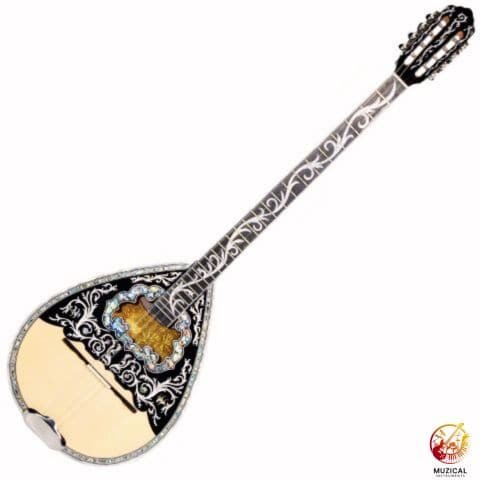
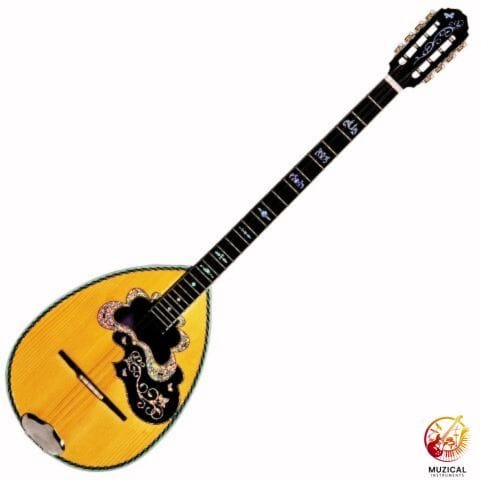
The instrument’s journey began in Turkey. Following a war, a major population exchange in 1923 forced nearly one and a half million Greek refugees to move to Greece. They settled in poor port cities like Piraeus, bringing their music with them.
In the rough urban neighborhoods and underground taverns, they created Rembetika, often called the Greek blues. The bouzouki became the voice for this community on the margins of society.
Its mournful sound was perfect for songs about pain, exile, and a rebellious spirit. Early players like the legendary Markos Vamvakaris weren’t trained musicians; they were ordinary men telling their stories.
For this reason, the instrument was looked down upon by the upper class and the government. Police often raided the taverns and smashed the instruments, but they could never stamp out the sound. This early six-string bouzouki, known as the trichordo, tells a powerful history of resilience.
Which Bouzouki Is Which? The Tale of Two Types
As the bouzouki moved from the underground into the mainstream, it changed. The biggest evolution was the addition of a fourth pair of strings, which created two distinct types of the instrument and a debate that continues to this day.
The original hero of the Rembetika era was the Trichordo, the six-string bouzouki. Used by legends like Markos Vamvakaris, its raw and sparse sound was the authentic voice of the Greek blues.
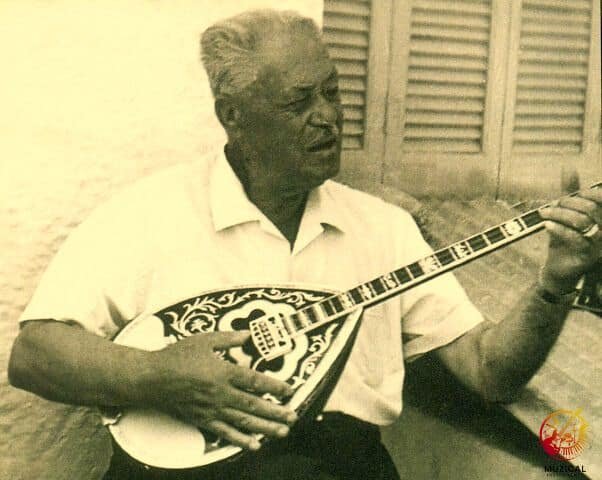
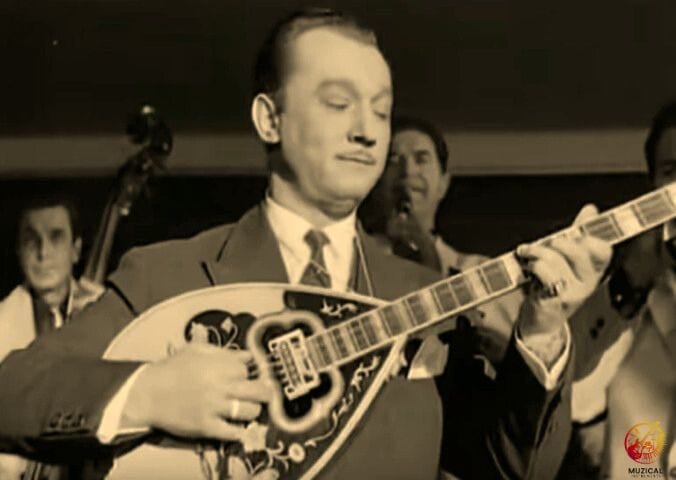
The trichordo was perfect for playing the powerful, Eastern-style melodies and hypnotic droning sounds of that early music, focusing less on complex chords.
Then, after World War II, the brilliant musician Manolis Chiotis wanted to expand the bouzouki’s range. He created the Tetrachordo by adding a fourth pair of strings, making it an eight-string instrument. He tuned it more like a guitar, which allowed for complex chords and flashy, fast solos. This is the bouzouki that became famous in popular Laïkó music and the one most people recognize today.
| Aspect | Trichordo (3-Course) | Tetrachordo (4-Course) |
|---|---|---|
| Number of Strings | 6 strings (in 3 pairs) | 8 strings (in 4 pairs) |
| Dominant Era | 1920s – 1950s (Rembetika) | 1950s – Present (Laïkó, Pop) |
| Key Innovator | Markos Vamvakaris (as a master) | Manolis Chiotis (as an innovator) |
| Common Tuning | D-A-D (modal) | C-F-A-D (guitar-like) |
| Playing Style | Melodic, modal, drone-focused | Chordal, virtuosic, Western-influenced |
| Cultural Feel | “The Greek Blues,” raw, authentic | Popular, orchestral, showman-like |
Expert Insight: Many modern luthiers and players see the trichordo and tetrachordo as two different instruments. Choosing between them depends entirely on the style of music you want to play. For the gritty, soulful sound of early Rembetika, the trichordo is king. For playing popular Greek songs and showcasing technical virtuosity, the tetrachordo is the standard.
How Did the Bouzouki Find a Second Home in Ireland?
One of the bouzouki’s most interesting stories has nothing to do with Greece, it takes place in Ireland. During the Irish folk music revival of the 1960s, musicians like Andy Irvine of the famous band Planxty discovered the Greek bouzouki. They loved its long, droning sound, which fit perfectly with traditional Irish tunes.

However, the instrument itself wasn’t quite right; the rounded bowl-back was awkward to hold and the tuning didn’t match the music.
So, they asked instrument makers to create a modified “Irish Bouzouki.” This new version kept the long neck but had a flat back like a guitar, making it more comfortable. Crucially, they changed the tuning to G-D-A-D. This was a genius move that allowed the instrument to provide a powerful, droning rhythm for jigs and reels.
Instead of playing the main melody, the Irish bouzouki became the rhythmic engine of the band. Musicians like Dónal Lunny perfected this style, creating a sound that is now essential to modern Irish folk music. It’s a perfect example of an instrument being adopted and completely reinvented by a new culture.
Where Should I Start If I Want to Learn to Play?
Ready to start playing the bouzouki? Your first step is to choose your style Greek or Irish as this decides which instrument and tuning to learn.
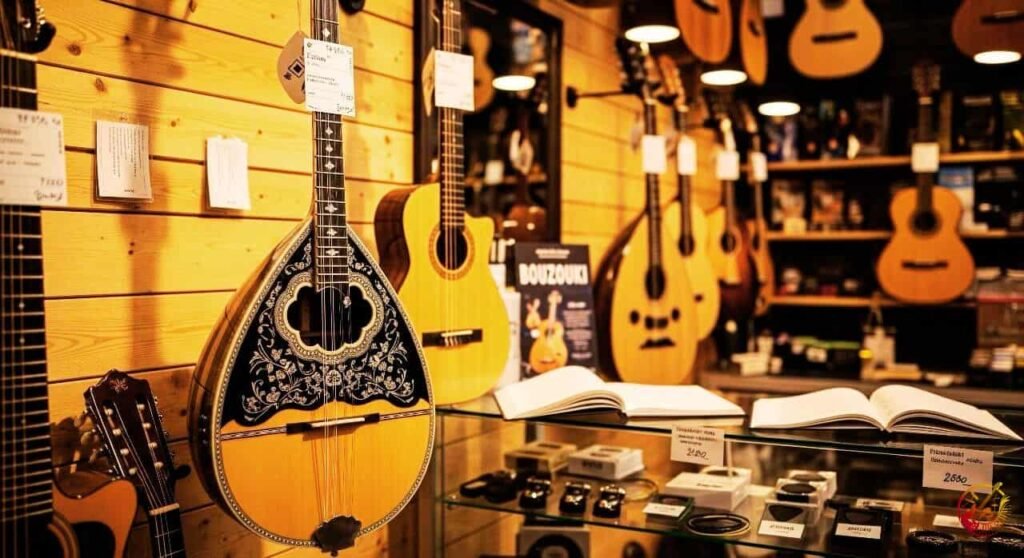
For the Greek style, an eight-string bouzouki is the best place to start. The standard tuning is C-F-A-D. The right-hand picking style is key to the instrument’s unique sound, but its technique can be tricky to learn on your own. For this reason, finding an experienced teacher is highly recommended to learn the right way from the beginning.
If you’re drawn to the Irish sound, you’ll want a flat-backed Irish bouzouki. Its most common tuning is G-D-A-D, which is perfect for playing the droning chords that drive Irish folk tunes.
No matter which path you choose, the best way to learn is to listen. To understand the different styles, listen to the masters: Markos Vamvakaris for Rembetika, Manolis Chiotis for popular Laïkó, and Dónal Lunny for the Irish style. Their music will be your best guide.
The Enduring Soul of a Modern Icon
To call the bouzouki a “Greek mandolin” is to miss the whole story. It’s not a copy of another instrument but a proud symbol of a people’s history, carrying both joy and sorrow in its shimmering sound.
From the old taverns of Piraeus to the lively pubs of Dublin, the bouzouki has proven to be a powerful voice, becoming the soul of one nation and a welcome friend to another.
So, the next time you hear it, listen closer. Can you pick out the sound of a soulful Rembetika song, a flashy Laïkó solo, or a driving Irish reel?
When you learn to hear the difference, you’re not just identifying an instrument, you’re hearing a story.
Listen to early songs by Markos Vamvakaris, then put on the first album by Planxty. This is how you will truly understand the rich, dual identity of the bouzouki the greek mandolin.
To see how the bouzouki compares to its cousin, explore the mandolin vs bouzouki differences in shape, tuning, and playing style.
FAQ: Bouzouki – The Greek Mandolin
Q1. Is the bouzouki the same as a mandolin?
No, it’s not the same though they look alike. The bouzouki is bigger, has a longer neck, and produces a sharper, more metallic sound. A mandolin usually has 8 strings in 4 courses and uses violin tuning, while a Greek bouzouki can have 6 or 8 strings with its own tuning system. Bouzoukis are made for Greek music, while mandolins are found in bluegrass, classical, and Italian folk.
Q2. How many strings does a bouzouki have?
There are two main types:
Trichordo bouzouki has 6 strings (3 courses of 2).
Tetrachordo bouzouki has 8 strings (4 courses of 2).
An Irish bouzouki also has 8 strings, but it’s tuned differently (often GDAD) and has a flat back.
Q3. What is the tuning of a bouzouki?
Trichordo: D–A–D
Tetrachordo: C–F–A–D
Irish Bouzouki: GDAD (or variations like GDAE, ADAD)
Each tuning gives you a different sound and feel. Tetrachordo tuning is great for full chords, while trichordo is perfect for Greek-style melodies.
Q4. Is bouzouki hard to learn?
Not if you start slow. If you’ve played guitar or mandolin, you’ll adjust quickly. Start by learning basic chords and picking patterns. Greek music uses a lot of melody and rhythm, so practice both. With time, your hands will memorize the patterns.
Q5. Can you play modern music on a bouzouki?
Yes, especially on a tetrachordo. Its tuning (C–F–A–D) lets you play many modern chords, even pop or jazz. The Irish bouzouki also fits well in folk, rock, or acoustic bands. It’s more flexible than many people think.
Q6. Can I use guitar chords on a bouzouki?
You can but they won’t sound the same unless you adjust for the tuning. Some tetrachordo players adapt guitar chord shapes, since the string intervals are similar. But trichordo and Irish tunings need new shapes. A chord chart for bouzouki will help a lot.
Q7. How much does a bouzouki cost?
Beginner models: $200–$500
Mid-range handcrafted bouzoukis: $600–$1,200
Professional luthier-made instruments: $1,500–$3,000+
